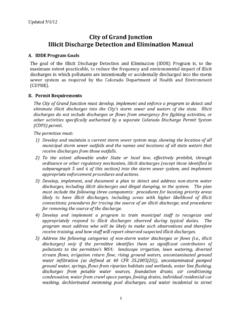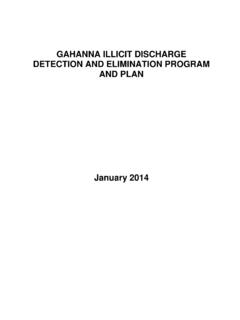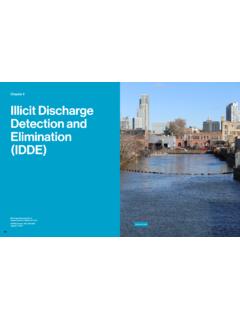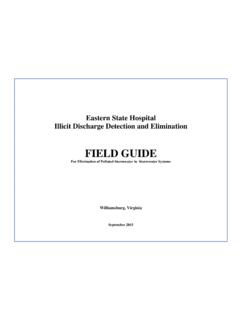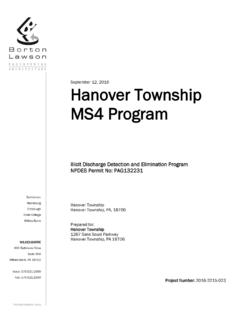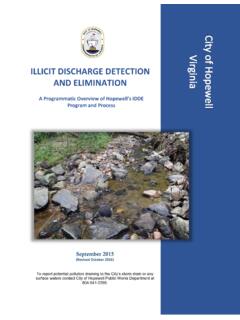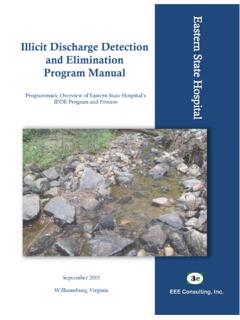Transcription of Illicit Discharge Detection and Elimination(IDDE)
1 Page 1 of 2 Illicit Discharge Detection and Elimination(IDDE) Phase I and Western Washington Phase II Municipal Stormwater Permits Proposed approach to update the IDDE tracking and reporting requirements for the 2019 permit reissuance. I. Introduction The Washington Department of Ecology (Ecology) is working on reissuing the Phase I and Western Washington Phase II Municipal Stormwater Permit. Ecology prepared preliminary draft permit language or narrative descriptions of specific permit sections and is accepting informal comments until 11 , January 19, 2018. Send your comments to: Or mail hard copies to: Municipal Stormwater Comments WA Department of Ecology Water Quality Program PO Box 47696 Olympia, WA 98504-7696 is a summary of several changes Ecology is proposing related to Permittees IDDE permit requirements.
2 Proposed permit language for the entire IDDE permit section will be released in spring 2018. Proposed changes to Phase II permit requirements 1. Move mapping requirements from to a new mapping section under changes to Phase I and WWA Phase II permits: 2. Proposed new Phase II / Phase I language in red: Recordkeeping: Each Permittee shall track and maintain records of the activities conducted tomeet the requirements of this section. In the annual report, each permittee shall submit data for allof the potential Illicit discharges, including spills and Illicit connections, found by or reported tothe Permittee during the previous calendar year.
3 The summary shall include the information andformatting specified in WQWebIDDE. Applicable data shall be reported for all potentialincidents, regardless of whether G3 notification was required, whether an Illicit Discharge wasconfirmed, or whether follow-up action was required by the Permittee. Each permittee may eitheruse their own system or WQWebIDDE for recording this data. Final submittal must follow theschema described in I and Western WA Phase II Municipal Stormwater Permit Preliminary Draft Permit Section: IDDE tracking and reporting 10/3/17 Page 2 of 2 3. Revised annual report question Phase II Q20/ Phase I Q48:Q20/48. Attach a summary of a zipped xml file with data describing the actions taken to investigate, characterize, trace and eliminate each potential Illicit Discharge found by or reported to the permittee.
4 For each confirmed Illicit Discharge , include a description of actions according to the required timeline per The submittal must include all of the applicable information and must follow the schema described in WQWebIDDE. annual report questions (PH II/PH I: Q15b/44b, Q19/47, and Q61 to readers: An IDDE incident tracking and reporting annual report question is in the current permit. Ecology issued guidance for permittees to meet this requirement but it was used by few permittees. Ecology wants the requirement to be meaningful and useful. The Stormwater Work Group stakeholder committee involved permittees in providing helpful definition and clarity to the expected reporting requirements.)
5 Ecology s IT department is building a form in the web portal that is primarily intended for use by permittees with smaller numbers (approximately <50) of incidents. Permittees with their own data bases should have their IT departments take a look at the data schema provided with this informal draft permit language. IDDE Reporting Schema Shane Homan for Karen Dinicola Page 2: English Page 5: Schema Page 17: Example IDDE Questions and Answers 1. Jurisdiction name (Permit Number) 2. Incident ID assigned by jurisdiction 3. Date incident reported 4. Date to begin response 5. Date to end response 6. Date of final resolution - Transferred to another party?
6 7. Discharge to MS4? - Yes a. Estimated Quantity - Unknown - Sheen - Less than 10 Gallons - 10 to 100 Gallons - 100 to 1,000 Gallons - 1,000 to 10,000 Gallons - Greater than 10,000 Gallons b. Discharge Frequency - Continuous or Ongoing - Intermittent - One-Time - No - Discharge Cleaned Up - Discharge to Combined sewer - Discharge to Private or other sewer - Other - Explain - Unknown 8. G3 notification? - Yes - ERTS case number - No 9. Incident location - Address - Street - City - State - Zip - Nearest Intersection - Tax Parcel - Latitude/Longitude - Latitude - Longitude 10. How was the incident discovered? - pollution hotline - (includes phone and/or web and/or mobile app) - direct report to staff - staff referral - other agency referral - ERTS - IDDE field observation - inspection - business - construction - catch basin or manhole - outfall or other MS4 - stormwater BMP - other - Explain - other - explain 11.
7 Pollutants identified: - none found - unconfirmed - not identified - unspecified - vehicle oil, fuel, or other lubricant - antifreeze or other coolant - sediment/soil - sewage/septage - solid waste/trash - food waste or oil - yard waste or other plant or wood waste - household or industrial chemical - Explain - carpet cleaning waste - fertilizer - pesticide or herbicide - bacteria - pet waste - soap/detergent - fire-fighting foam - other or unknown foam - heating oil or kerosene - roofing or road tar - cement, concrete, lime, or plaster - paint (oil based) - paint (latex) - PCBs - refrigerant - chlorinated water - other - Explain 12.
8 Source or cause: - n/a - allowable Discharge - Diverted stream flow - Flow from riparian habitat or wetland - Uncontaminated ground water or spring water - Foundation or footing drain - Uncontaminated water from crawl space pump - Air conditioning condensation - Irrigation water from agricultural source - Emergency firefighting - conditionally allowed Discharge - Potable water - Water line flushing or testing - Lawn watering or other irrigation - Dechlorinated pool/spa water - Street/sidewalk wash water - not identified - Illicit connection - dumping - spill - vehicle collision/accident - construction activity - construction BMP failure - structural
9 BMP failure - runoff due to drainage or grade conditions - stormwater or flood water - groundwater pumping - broken or clogged water or sewer line - septic system - leaking or abandoned container/dumpster - non-emergency firefighting or training - fueling - auto repair - vehicle washing - vehicle leakage/fluids - equipment cleaning - pressure washing - drive-thru - mobile business - retail operations - restaurant - logging - livestock - other - Explain 13. Source tracing: - n/a - visual observation - map analysis - further inspection or reconnaissance - indicator testing - dye testing - pressure testing - smoke testing - video inspection - canine Detection - optical brightener - sand bagging - smell/odor - other - Explain 14.
10 Indicator testing: - n/a - flow/ Discharge - sheen/oil - floatables - detergent or surfactants - ammonia - color - odor - pH - temperature - turbidity - hardness - nitrates - potassium - specific conductivity - bacteria - chloride/chlorine - fluoride - carbon monoxide - hydrogen sulfide - other - Explain 15. Correction/elimination methods: - no action needed - Explain - clean-up - education/technical assistance - add or improve source control BMP - focus on structural - behavioral or BMP operation modification - focus on operational - enforcement: - verbal notice - written warning - correction notice - stop work order - legal notice - penalty or fine - referred to other agency or department - follow-up or further investigation - problem not abated - Explain - Other - Explain 16.


